TARUS recently accelerated its clay milling machine performance and its digital transformation with Siemens SINUMERIK ONE.
Invention and innovation are the lifeblood of family-owned and family-run TARUS, the only U.S.-based manufacturer of clay milling machines for vehicle design. In 1984, the Sterling Heights, Michigan-based company completely changed the automotive industry when it introduced the world to its invention, the Claymill™.
With full milling and scanning capabilities for the sculpting of concept vehicle designs, this groundbreaking CNC milling machine set the tone — and set a high bar of expectations — for TARUS that guides its leaders to this day.
Fueled by visionary thinking and ingenuity, TARUS remains the leader in car design studio solutions. To maintain market dominance and meet accelerating customer demands, TARUS owners — and brothers —Dave and Doug Greig realized they needed to elevate and enhance the capabilities of their clay milling machines. They found their answer in the equally innovative, revolutionary SINUMERIK ONE machine control from Siemens. Their decision charted a new way forward for TARUS that aligns with the company’s cutting-edge reputation and clears a path for further innovations in the years to come.

Founded in 1969 in family patriarch Douglas J. Greig’s garage in Warren, Michigan, TARUS established its reputation as an innovator throughout the 1970s. It built controls and machines with first-of-its-kind features that others soon adopted. In 1980, TARUS introduced its own CNC control. A year later, it released a next-generation machine with a control featuring a first-of-its kind graphical user interface. Called the TPI 8100 CNC, this machine’s control had 3D graphics and powered high-speed contour milling for mold and die makers, among other high-tech options.
Equipped with this in-house, in-demand control and its successors, TARUS-built machines were fast, smooth, accurate, and reliable. Customers loved the look of the control’s interface and the machines’ reliable, repeatable results. In 1984, TARUS and General Motors teamed up to develop a portable clay milling machine—the world’s first purpose-built industrial clay milling machine. The TARUS Claymill quickly became the automotive industry standard. These machines mill clay, dense foam, and polyurethane for design and surface verification models for future vehicle designs.
As its success bred more success, TARUS spent the ensuing decades as the global leader in car design studio solutions. With the auto industry evolving to incorporate electric vehicles and its competition growing, TARUS took another leap forward. Further enhancing the capabilities of its industry leading graphical user interface, TARUS adopted the SINUMERIK ONE control, merging reliability and performance with the functionality and user friendliness of the TARUS Claymill CNC.
“SINUMERIK ONE came at the right time,” Dave Grieg said. “We were looking to make a change that would bring added performance while also allowing us to keep our graphical user interface designed for clay modelers. That gives us our edge. With the Siemens control powering our machines, modelers can do things they never could do before.”
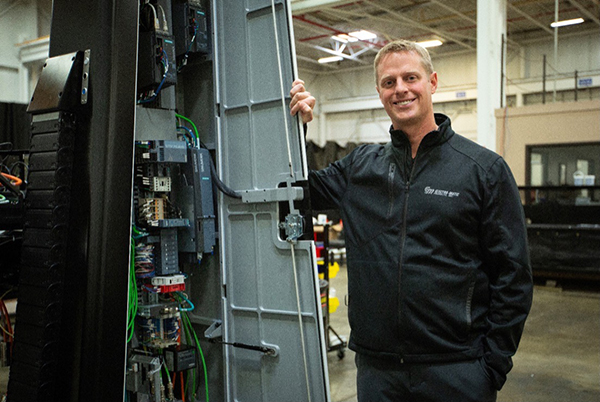
Timing was key to the TARUS-Siemens partnership. Scott Doyle of Electro-Matic, the trusted solution provider and technology partner for TARUS, knew the needs of his client.
“Understanding exactly what TARUS does and its superior motion control — a lot of what TARUS was doing was right up Siemens’ alley,” said Doyle, vice president of OEM sales at Electro-Matic. “The opportunity was crystal clear.”
Doyle introduced Doug and Dave to Siemens technology and were assured the multi- technology SINUMERIK ONE could boost the performance of TARUS machines while retaining the company’s cornerstone graphical user interface.
“We took the SINUMERIK ONE package, we implemented it, and we tweaked it for our interface,” Doug said. “Now we have an extremely high-performance CNC machine control with our user interface, which customers love, and it’s very easy to use.”
Customers using the TARUS Claymill for their life-size vehicle models are “ecstatic,” Dave added. “It’s solid, it runs a lot faster, it’s smoother, quieter — everything. The machines are running consistently and reliably.”
TARUS and its customers are now realizing benefits across the production cycle, from machine setup and customization to machine performance and throughput.
Most important to Dave, Doug and their customers is the familiar look and feel of the TARUS control. This was their biggest concern and biggest question when adapting TARUS machines to SINUMERIK ONE. The process took about one year, involving collaboration between Siemens and TARUS staff, and the results are unrivaled in the industry, Doug said.
“Nobody has the user interface like we have with the reliability of SINUMERIK ONE. That’s the secret sauce,” he said. “Because we already wrote our own software for our own control, we were able to make these two things work together for our customers’ benefit.”
Users experience the trust and familiarity of the TARUS interface, but with superior machine performance. Surface quality, precise cuts, cycle times, and reliability are critical to TARUS and its customers as they mill the clay into future vehicle models. In fact, it is the precision of the cutting tools that produce desired surface finishes and eliminate time-consuming hand sculpting.
Dave said customers who use TARUS machines as an extension of their own design sculpting teams are indeed achieving a higher-quality surface that rarely requires smoothing by hand.
“Our machines cut so precisely now that they don’t have to refine it,” he said. “It’s saving them valuable time.”
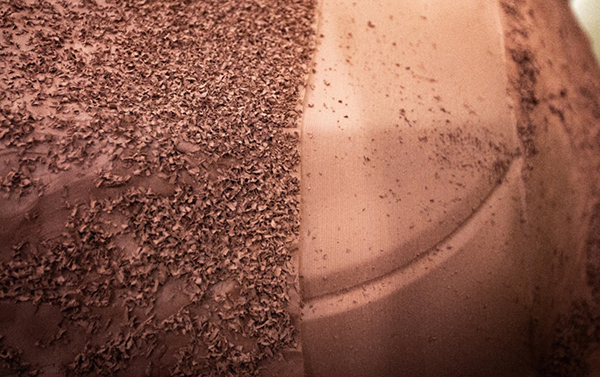
“In processing power alone, SINUMERIK ONE is 30% faster,” said Chris Grimm, OEM sales account manager at Siemens. Testifying to that claim, Doyle has seen the results first-hand with TARUS’s internal machines. “Their throughput has increased tremendously,” he said.
Customers are saving even more time during the design and milling phase the car models, as the TARUS software enables changes on the fly.
Doug explains: “With our software, customers have a choice. They can mill a car model, and if they want a small change, they can sculpt it by hand, then measure it. They can scan it with their scanning system, then they can mill it on the other side of the model. Or they can send it back to their CAD system so that they’ve archived the change. Sometimes, they decide to make the change with the machine. They talk to the designer or 3D modeler, and that person a change to the program, and then go back and mill it. There’s a lot of give and take with clay modeling. Our controls allow this to happen.”
Doug also emphasized reliability as an important customer benefit. Reliability means less downtime, which increases output, he said, calling the SINUMERIK ONE “one of the most reliable in the world.”
“The SINUMERIK ONE greatly improved reliability compared to our previous solution. Reliability translates into increased productivity for the customer, decreased warranty costs for TARUS and greater confidence when selling these machines to new and existing customers.”
SINUMERIK ONE is particularly helpful during machine setup and deployment, Doug said. Using a process he calls “cloning,” the TARUS team can program one machine and replicate it across multiple machines.
“We take the settings from one machine and put them on the next machine, turn it on, and it works,” he said. “Every machine acts just the same as the one we just built.”
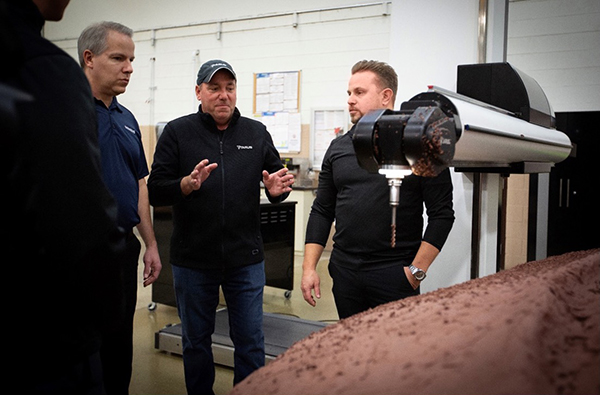
Although Dave and Doug are focused on the here and now, ensuring immediate results internally and for their customers, they also are thinking long-term. That’s another reason the brothers felt comfortable switching from an in-house control. As a relatively new innovation built upon a legacy of success, Siemens will support SINUMERIK ONE for many decades to come. TARUS and its customers will have no issues obtaining new parts or customer service — from both Electro-Matic and Siemens.
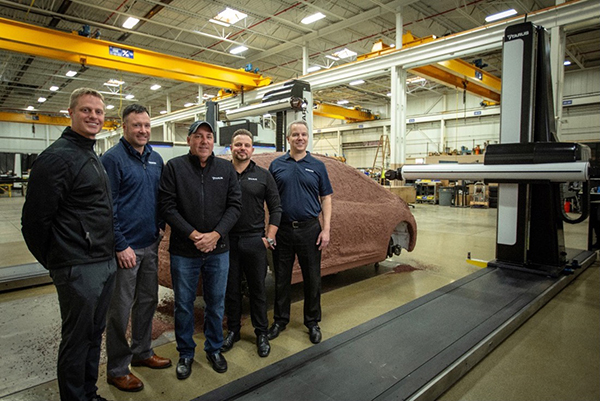
“The availability of replacement parts for years to come—that’s a big deal,” Doug said. “When the parts come in, we know they’re going to work. They’re plug-and-play — and Siemens maintains the supply chain too.”
Customer support is a collaborative effort between Electro-Matic and Siemens. Electro- Matic has in-house application engineers who can visit TARUS and provide product support up to a certain level of complexity before bringing in the support of the local Siemens application engineer, Doyle said.
As a pilot customer, TARUS was one of the first U.S. machine builders to take advantage of the power and capabilities of SINUMERIK ONE. That gave the company a jump-start on the market — and it has kept its foot on the gas ever since.
“Our competitors don’t have anything like this,” Doug said.
“If you compare our machines, bone to bone, to any other thing out there, it’s not even close. Everyone else is making what we made 30 years ago,” Dave added. “That’s the difference.”
As beneficial as the switch to SINUMERIK ONE has been for TARUS, there’s room for more growth. The control package has features and options TARUS has only begun to explore, options that are particularly well-suited for other markets, including aerospace. Doug has already thought about expanding into manufacturing CNC machines for customers that make parts for the aerospace industry.
No matter the market, features of SINUMERIK ONE such as the digital twin can play a part. The digital twin is a virtual representation of a physical machine or process used to understand and predict the physical counterpart’s performance characteristics. Digital twins are used throughout the life cycle to simulate, predict, and optimize the product and production system before investing in physical prototypes and assets.
“Leveraging the digital twin and running parts virtually first before you actually put them on the machine so they can get accurate quotes for how long it might take for end- customers to do a mold or a die is a powerful option,” said Brian McMinn, business segment manager of Machine Tool Systems at Siemens. “Training benefits from the digital twin as well. TARUS can train customers virtually before the machine even arrives at their location.” The possibilities are appealing to Doug, especially in how TARUS supports its customers. “100% remote monitoring and repair of the machine is 100% possible,” he said.
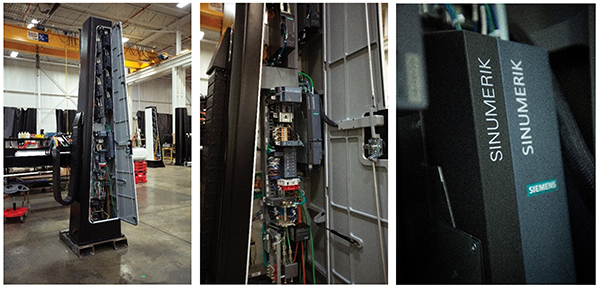
Building on its storied past, TARUS has successfully added a pivotal piece to its foundation. With SINUMERIK ONE, the company has elevated its ability to innovate and remains a versatile industry leader with superior clay milling capabilities for its customers. And the TARUS evolution will continue. Dave and Doug, along with Electro-Matic and Siemens, are gearing up for even more advancements.
At Siemens, the design and engineering teams are learning more and more about TARUS and its desire to push the envelope, opening up the SINUMERIK ONE playbook. Nothing, seemingly, is off the table for this innovative trio of companies.
Knowing TARUS wants the control to be one of the differentiators for its machines, McMinn sees software efficiencies on the horizon that can help improve production.
“TARUS is always looking at different features, different software licenses or compile cycles to get more productivity out of the control,” he said.
The reliability of SINUMERIK ONE frees up TARUS team members to implement improvements and customer-requested advancements since they don’t have to worry about the technology driving the machine’s performance.
“Now TARUS is freed up to develop other features that are more interesting and more relevant for our customers,” Doug said. “Like enhancing the graphical user interface or optimizing the CAM system that programs the user interface.”
For now, though, Doug knows the decision he and his brother made years ago is paying off today for TARUS and its customers. “Just as dynamic new car designs are imagined and realized, TARUS and Siemens are re-imagining and innovating machines, controls and processes that help bring visions to reality,” he said. “This is truly an exciting time for manufacturing.”
Web-page: http://usa.siemens.com/tarus
For more information, please contact:
John Meyer
Marketing Communications Manager
Siemens Industry, Inc.
Digital Industries — Motion Control
390 Kent Avenue
Elk Grove Village, IL 60007
+1 847 952 4158
john.meyer@siemens.com
Siemens Corporation is a U.S. subsidiary of Siemens AG, a leading technology company focused on industry, infrastructure, transport, and healthcare. From more resource-efficient factories, resilient supply chains, and smarter buildings and grids, to cleaner and more comfortable transportation as well as advanced healthcare, the company creates technology with purpose, adding real value for customers. By combining the real and the digital worlds, Siemens empowers its customers to transform their industries and markets, helping them to transform the everyday for billions of people. Siemens also owns a majority stake in the publicly listed company Siemens Healthineers, a global leading medical technology provider shaping the future of healthcare. In addition, Siemens holds a minority stake in Siemens Energy, a global leader in the transmission and generation of electrical power. In fiscal 2023, which ended on September 30, 2023, the Siemens Group USA generated revenue of $19.9 billion and employs approximately 45,000 people serving customers in all 50 states and Puerto Rico.
About TARUS
Founded in 1969, TARUS is an award-winning, vertically integrated family-owned company based in Metropolitan Detroit with global customers in North America, Europe, Asia, Australia, and South America.
TARUS is the world leader in car design studio solutions, and a world leader in application specific 5-axis CNC machines for aerospace, automotive, mold & die, heavy industry, defense & military, oil & gas, and nuclear power generation.
Corporate Contact:
George Cook
VP, Sales and Marketing
TARUS
gcook@tarus.com
+1 586 977 1400
Scott Ellyson, CEO of East West Manufacturing, brings decades of global manufacturing and supply chain leadership to the conversation. In this episode, he shares practical insights on scaling operations, navigating complexity, and building resilient manufacturing networks in an increasingly connected world.